
Lincoln, Neb. —The Institute of Agriculture and Natural Resources (IANR) at the University of Nebraska has continued its upward trajectory in securing research funding for critical projects despite the pandemic.
IANR faculty teams were awarded $64 million in externally-sponsored research grants and contracts for the 2021 fiscal year, which ran from July 1, 2020 to June 30, 2021. This is the highest dollar amount in research funding that IANR has received in a single year, topping the institute’s previous high of $59.9 million in 2020. Dollars awarded for sponsored research have increased in IANR at an annual rate of 4.8% since fiscal year 2012, and the number of active externally-sponsored awards increased to over 470 during the 2021 fiscal year.
About 80% of the funding came from federal agencies, including the U.S. Department of Agriculture (USDA), the National Science Foundation (NSF), the Department of Energy (DoE) and the U.S. Department of Health and Human Services (DHHS). Industry partners, state agencies, and commodity boards contributed to 20% of the total funding.
“These funds keep the University of Nebraska in a global research leadership position in food security and resilient natural and agricultural systems,” said Archie Clutter, dean of the Agricultural Research Division in IANR. “The integrated projects led by our faculty will help ensure environmentally and economically sustainable cropping and food animal systems, new connections of food to human health, and the well-equipped workforce these and other specialized areas of agriculture will require.”
Highlights of projects funded during fiscal year 2021 include:
- $6 million from NSF to lead a four-institution team to build a one-of-a-kind database from streams, lakes and other inland water systems across the nation, and enable studies of how changing waterways impact ecosystems on regional and national scales.
- $3 million from DoE for the development of novel commercial farm-field networks to quantify and understand greenhouse gas emissions from agricultural bioenergy feedstock production.
- $3 million from USDA to support the development of high intensity sites for collection of new measurements of plant characteristics (phenomes) through novel imaging and UAV technologies, and advance understanding of the connection of genomes to phenomes, with focus on maize and wheat.
- $2.3 million from USDA to expand the National Drought Mitigation Center’s drought information services for entities and agricultural producers across the United States, enhancing its role in providing national, state, tribal, and local scale drought information services to support the U.S. agricultural sector and multiple USDA agencies, including the USDA Climate Hubs.
- $1.2 million from DHHS for the development of automated computational tools for studies of carbohydrate metabolism in the gut microbiome aimed at improved human health through personalized nutrition.
- $ 1 million from USDA to establish a scalable framework for next-generation variable-rate applications of water and nutrients in agriculture to enable real-time accurate decision making, increased efficiency of water use, reduced environmental impacts, and sustained food and energy crop production in the corn belt.
“The success of our faculty members in winning so many highly competitive grants and awards is a testament to the strength of their research, as well as to their dedication to their work, the university and the people of Nebraska, said Mike Boehm, NU vice president and Harlan vice chancellor for IANR. “Every day, I am blown away by IANR’s extremely talented and hardworking faculty, and the breadth and scope of their research. It is wonderful to see their work being recognized, rewarded and advanced.







